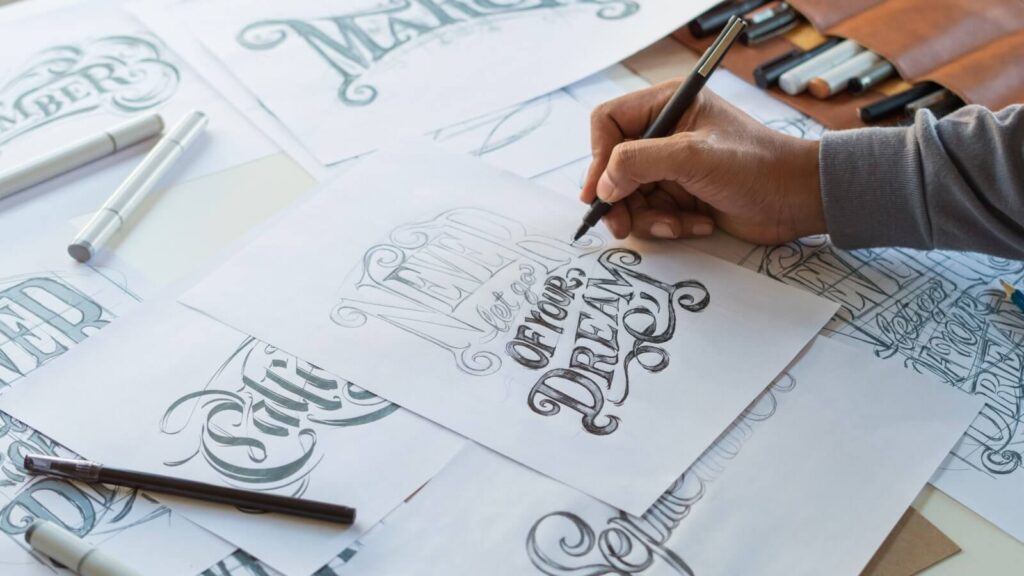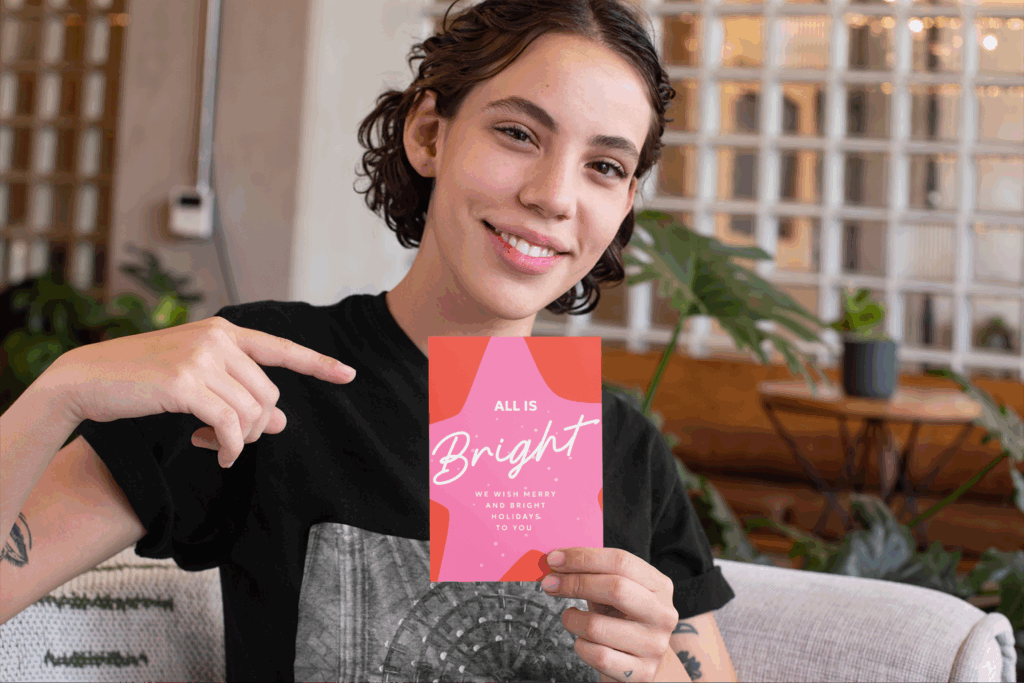Bring your design ideas to life
Are fonts copyrighted? It’s a common question, especially when creating designs or publishing content. Fonts play a significant role in expressing ourselves online and in print, so understanding the copyright rules around them is essential.
This article is your one-stop shop for everything you need to know about copyright protection before slapping those cool fonts on your merch and raking in the dough. Let’s unravel the mysteries of font copyrights and set you on the path to stylish – and legal – success.
Key takeaways
- Font software is protected under copyright law, which governs its use, distribution, and modification.
- Different types of font family licenses specify how fonts can be used commercially, including restrictions on modifications and distributions.
- You must purchase commercial fonts to use them legally, especially in business contexts. Many free fonts have limitations for business use.
- Using fonts without proper licensing can have hefty legal consequences, including costly lawsuits.
- Font copyright laws are different in the US and other countries. This will affect which designs you can legally sell and where.
What are copyright laws?

Copyright laws are designed to protect intellectual properties, like the artistic elements and design patents associated with fonts. There are usually different copyright rules for the font itself and the typeface.
The typeface is the overall design of the letters – their unique style and personality – while the font is the digital file that allows you to use that typeface on your computer.
The computer programs within font software are protected by copyright, but the actual design of the letters themselves might not be. It depends on how original the design is and whether it’s been officially documented or registered.
Let’s learn a bit more about copyright and how to navigate rules and legal precedents for different fonts, from freely available ones like many Google Fonts to those with commercial use restrictions.
Understanding font copyright basics

What is copyright?
Copyright is a set of laws protecting creators of original works by giving them exclusive rights to reproduce, distribute, and display their creations. This is especially important for fonts and typeface designs used in both digital and printed media.
Copyright protection applies to the font program – the computer program that renders the font on screens and in print – but not necessarily to the typeface design, which is the arrangement of the letters and characters.
This doesn’t mean your typed words are copyrighted, but rather how a typeface is designed. While the general idea behind a font (like a handwritten style) can’t be copyrighted, the unique execution of that idea (individual shapes, curves, and details) can be.
Under the Copyright Act, the font program is protected, though the protection does not always extend to the typeface or individual character design.
Type fonts, which refer to a font family’s specific styles and weights, may have separate licensing conditions depending on their unique characteristics and uses.
The specifics of font copyright
Font licenses specify how a font can be used, modified, and distributed. These licenses are crucial for anyone looking to use fonts commercially, as they define how you’re allowed to use them.
Computer software – which includes the code that displays the font on a computer or printer – generally has copyright protection. However, the typeface design, which refers to the aesthetic and visual arrangement of the letters, might not be copyrighted unless it qualifies as a distinct artistic work under copyright law.
Font software, different from typeface design, is protected by copyright law, which provides legal control over the replication and distribution of font files.
While the software itself is protected, the broader concept of the typeface may not be unless certain design elements or original artistic qualities are present that qualify for protection under copyright laws.
Types of fonts and legal considerations

Free vs commercial fonts
While free fonts are appealing, they have limitations and potential legal pitfalls.
Free fonts are often offered for personal use only, meaning you can use them for personal projects, social media graphics, or non-commercial designs. Using free fonts for commercial purposes, such as logos, websites, or products for sale, can land you in hot water.
Commercial typeface designs come with a license that grants you specific rights for use. These licenses can vary widely. Some give basic permission for desktop and individual use, while others allow fonts to be used in large-scale commercial projects or even permit modifications and redistribution of the font.
If you’re unsure whether a font is free or commercial, always check its license agreement.
Understanding licenses and restrictions
Font licenses are legal agreements outlining how to use a particular font.
They typically cover:
- Commercial use – Using the font in products or services for sale.
- Modifications – Changing the font’s design or creating new fonts based on it.
- Distribution – Sharing or embedding the font with others.
- Number of users – How many people can use the font within your organization.
Other licenses, like app licenses, give permission to add fonts to mobile apps or other media. Each license type specifies restrictions such as acceptable use, the number of installations, and whether the fonts can be embedded in digital or physical products.
Pro tips for using fonts
Need to use a font in a way that’s not covered by the usual agreement? You’ll likely need special permission, especially for big projects or commercial uses. Always read the fine print on those licenses to understand what’s allowed and what’s not.
Open-source fonts are a flexible option since they often allow for changes and commercial use without extra fees, but even those have rules you’ll need to follow. And don’t forget – using fonts on websites might require a special web font license.
Legal challenges and protections

Copyright infringement cases
Using fonts the wrong way can get you in legal trouble. It’s not just about copyright – you could also face issues if you use a font in a way that confuses people about where it came from, especially if it’s a well-known or trademarked font.
Several high-profile cases have highlighted the importance of respecting licenses and understanding the legal boundaries of font usage.
For example, NBCUniversal faced multiple lawsuits for using fonts beyond the agreed licensing terms, with claims reaching millions of dollars. Similarly, Font Bureau and P22 Type Foundry sued NBCUniversal for $2 million because they used a font in promotional materials, going against the font licensing agreement.
Other notable legal precedent cases:
- Nike font lawsuit. Production Type filed a copyright infringement lawsuit against Nike for allegedly using their well-known trademark font, Kreuz Light, in various marketing campaigns without proper licensing.
This notable lawsuit focused on using a proprietary font in commercial advertising without permission, highlighting the legal risks of ignoring these rules. - House Industries lawsuits. House Industries has pursued legal action against several companies, including Shake Shack, Rite Aid, and Michaels, for allegedly infringing on their copyrighted fonts.
Verifying the copyright status of fonts before using them can prevent potential legal challenges and financial liabilities.
Protecting your own font creations
Protecting your font creations is a must if you’re a type designer. Copyright law automatically protects original font designs once they’re created, but registering your font with the copyright office has additional legal benefits.
Registration establishes a public record of your copyright and lets you seek compensation in case of infringement. To register your font, you must submit an application, provide a copy of your font software, and pay a filing fee to the copyright office.
Font protection guidelines:
- Securing copyright protection for unique fonts, especially those with distinctive typeface shapes, is essential for legal security.
- Registering the font file with the trademark office may provide additional legal protection for many fonts with distinctive characters, punctuation marks, or potential brand value.
- Consider filing copyright registration for your original fonts and font families to legally protect your designs from unauthorized use.
- Be aware of font law cases related to printer or computer display programs, as these may impact the use and distribution of such fonts.
- Understand that typeface refers to the overall design of letter forms, while the font is the specific style and size of that typeface. Knowing this distinction can help you properly protect your work.
- Remember that trademarked fonts like Palatino and other popular typefaces have specific legal protections you should be aware of to avoid infringement issues.
Font copyright in practice

Using fonts correctly is critical for both designers and businesses. It’s all about staying on the right side of the law and respecting the hard work that goes into creating those awesome typefaces.
This section will give you the lowdown on legally using fonts in all your projects so you can create cool stuff without any hiccups. We’ll cover everything from picking the right fonts to understanding licenses.
Using fonts in designs and products
Choosing the perfect font for your logo or product is essential, but understanding the legal side is just as important. Copyright issues can pop up if you’re not careful, especially when using fonts on commercial products like print-on-demand items.
Each font has its own rules about how it can be used, so make sure you know the details before designing. This will help you avoid copyright infringement.
What to keep your eye on:
- Double-check that the font you’re using matches the one listed in your license agreement.
- When you start creating products with Printify, you get access to our Product Creator, which offers countless free fonts to use worry-free.
- To avoid infringement, always ensure that particular fonts used in logo design or product labeling are covered under your licensing agreement.
Violating font licensing terms can lead to legal action from designers or foundries, especially if the font is key to a brand’s visual identity. Ensure the license covers your intended commercial use to avoid costly disputes and respect the creators’ rights.
Best practices for font usage

Follow these guidelines to incorporate fonts confidently into your designs and products, respect the legal rights of type designers, and avoid potential copyright infringement issues.
- Read the license agreement – Always thoroughly review the license agreement for any font you use. Understand the terms regarding commercial use, modifications, and distribution rights.
- Choose the right license – If you plan to use a font for commercial purposes, ensure you have the appropriate commercial license. Don’t assume that a free font is automatically available for commercial use.
- Respect intellectual property – Fonts are the creative works of type designers. Respect their intellectual property by using fonts legally and giving credit when required.
- Maintain records of your licenses – Keep track of all your licenses and their terms for easy reference and to avoid any confusion about usage rights.
Make your fonts come to life with Printify


Make your artistic works come to life – start creating your own designs on custom products and sell them online for profit! Whether you’ve created your own fonts or have proper licensing for fonts you’ve found, you can bring them to life on awesome products from Printify.
Use fonts to create eye-catching merchandise and grow your online business with ease.
FAQ
Yes, you can be sued for using a font if it is copyrighted and you use it without the appropriate license or permission.
Fonts in the public domain or those explicitly released under open-source licenses (like SIL Open Font License) are not copyrighted.
Check the font’s documentation or the website you downloaded it from. Most licensed fonts will tell you about their copyrights and how you can use them.
You’re good to go if you download a font that’s offered for free, available for purchase from the owner, or has an open license. Just make sure you stick to the rules set by whoever created it.
Conclusion
Fonts are protected by copyright law, and using them without proper licensing can lead to serious consequences. But aside from following the law, it’s important to do the right thing – respect other artists’ work.
By honoring the intellectual property of type designers and adhering to license agreements, you’ll avoid legal trouble and contribute to a healthier creative community.
Remember – knowledge is power. Educate yourself on the intricacies of font copyright, explore both free and commercial fonts, and prioritize getting the correct licenses for the fonts you wish to use. Getting this info empowers you to make wise decisions, protect your work, and unleash your creativity without fear of legal repercussions.












